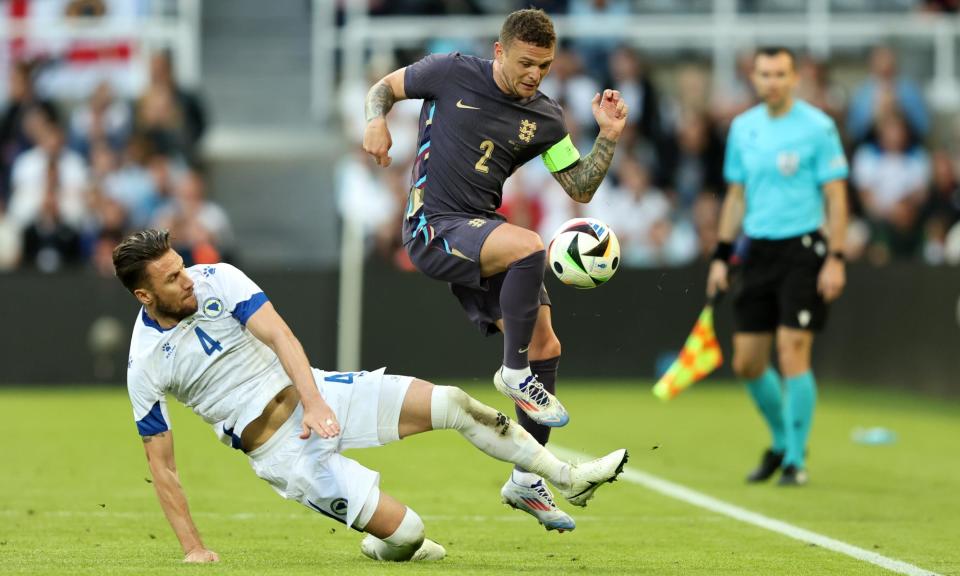Southgate left to sweat over Shaw and England’s limited options at left-back

The quest for balance occupied England’s thoughts for much of this 3-0 win over Bosnia and Herzegovina. An experimental lineup laboured for long spells and, although there was plenty of promise from Cole Palmer and Eberechi Eze on their first international starts, the concern for Gareth Southgate has to be that there were just as many moments when the attack struggled to function without the added threat of Luke Shaw’s overlapping runs on the left flank.
It is an obvious area of potential weakness for England before they head to Germany with dreams of becoming European champions. Will Shaw make it back in time? Southgate needs him. He does not have another recognised left-back at his disposal. There was no place for Ben Chilwell or Tyrick Mitchell in England’s provisional 33-man squad.
Related: Cole Palmer keeps his cool for England breakthrough in victory over Bosnia
So much is riding on Shaw making it back in time for the European Championship and, while there have been optimistic noises about his recovery from injury, the fact remains that nobody can be sure about whether the Manchester United defender can be trusted to make it unscathed through seven tournament games given that he has been out since February.
But Southgate has gambled. In a move reminiscent of Glenn Hoddle selecting Graeme Le Saux as England’s only left-back at the 1998 World Cup, the head coach has not named an obvious deputy for Shaw. He simply has to hope that he will not encounter the same problem as Hoddle did all those years ago. Perhaps Southgate will even recall that he was the player who had to come on and play out of position on the left when Le Saux was forced off in the second half of England’s defeat by Argentina in the last 16.
Of course, the intention is not to criticise Kieran Trippier, who is likely to fill in at left-back if Shaw is not back for England’s opening game against Serbia on 16 June. Even so, the situation is clearly less than ideal. Trippier has many strengths. He is experienced, dependable, tenacious and a fine crosser of the ball from the right. What he is not, though, is left-footed and so, for all his willingness and determination to support the attack, his instinct will always be to turn inside and move back on to his stronger right side.
Does it mean England are doomed? No. After all, they reached the semi-finals of the 2018 World Cup with the right-footed Ashley Young playing at left wing-back. There are always solutions. Players can thrive in unfamiliar positions and Trippier is no stranger to playing at left-back for England. He was there when they beat Croatia in their opening game at Euro 2020.
Yet his limitations were hard to ignore during the first half against Bosnia and Herzegovina. England were too narrow and congested. Every time the fearless, impressive Eze went on one of his daring dribbles and ghosted inside from the left, it was crying out for someone to charge down the inside. Faced by a deep, burly, often cynical defence, they needed to vary the angles and play with more width.
The mind went back to Shaw’s fizzing low deliveries at Euro 2020; his assist in the last- 16 win over Germany. Trippier, though, plays a more restrained game. He was reluctant to burst into the final third here. It made it harder for Eze, who needed more support.
Not that Eze had a bad game. There was one beautiful, slaloming run from the Palace playmaker, who was quick to combine with Palmer, and ultimately this went down as a positive exercise from Southgate’s perspective. He will be pleased with England’s response after half-time. There was more intensity, more bite. Palmer, who created an early chance for the disappointing Ollie Watkins, grew in influence. It was not a coincidence that England’s improvement coincided with Palmer getting on the ball more in the final third.
Related: ‘It’s going to be difficult’: Southgate agonises over seven-player squad cut
This was a night for seizing opportunities. Palmer was nerveless when he had the chance to score his first England goal from the spot. Jarrod Bowen was lively on the right. Doubts over their places in the final 26 ensured that Jack Grealish and James Maddison were full of motivation when they came on in the second half.
Questions persist, though. Maddison was imaginative in the second half and it was a boost for Grealish to set up Trent Alexander-Arnold’s stunning late volley. Yet the overall balance of the team was unconvincing. Some players toiled. Marc Guéhi’s distribution at the back was poor at times, Watkins did not link the play well up front and it was hard to tell if Alexander-Arnold, whose goal came after he shifted to right-back, is the right player to fill the third midfield spot.
Bosnia and Herzegovina were limited opposition. Alexander-Arnold had plenty of the ball and did not do much with it alongside Conor Gallagher. Southgate will dwell on that lost, timid first half. He will spend the next few days fretting about Shaw. England need his driving runs down the left. They could be the difference between success and failure this summer.

